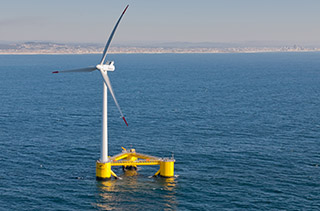The first offshore wind energy project proposed for California would be an array of 100 floating turbines generating up to 800 megawatts, the latest in proposals for deepwater Pacific sites.
Trident Winds LLC, Seattle, Wash., would lease nearly 68,000 acres of ocean bottom through the federal Bureau of Ocean Energy Management, about 30 miles northwest of Morro Bay, Calif., according to the unsolicited bid the company submitted Jan. 14. BOEM officials said this week they have qualified Trident’s legal and financial abilities and will begin a detailed review of the proposal.
 A BOEM map shows the proposed wind development area off California.The area is roughly an arc with its closest approach to land 20 miles off Point Piedres Blanca and the San Luis Obispo-Monterey County line. It is right up against the southwest corner of the Monterey Bay National Marine Sanctuary, in waters 2,600’ to 3,300’ deep.
A BOEM map shows the proposed wind development area off California.The area is roughly an arc with its closest approach to land 20 miles off Point Piedres Blanca and the San Luis Obispo-Monterey County line. It is right up against the southwest corner of the Monterey Bay National Marine Sanctuary, in waters 2,600’ to 3,300’ deep.
In their application to BOEM, Trident company officials say they have been reaching out to other agencies at all levels of government and other stakeholders – notably environmental groups that have a lot of sway over coastal management decisions in California.
The company says it has been talking to Morro Bay commercial fishermen too, and drew its proposed area with an eye to avoiding conflicts. On its website, Trident says “there is no exclusion zone required on the wind farm perimeter, but the area will prohibit commercial fish trawling and netting.”
Water depths in the area make seafloor interconnection cables impractical, so cables between the turbines would be supported with subsurface buoys, according to the application. A single cable would carry power to shore at a Pacific Gas & Electric substation, adjacent to a decommissioned power plant where an old cooling water intake will be used to route the cable to land.
Trident was founded by Alla Weinstein, a founding president and former CEO of Principle Power Inc., a technology company that developed floating turbine designs and is partnering in projects proposed off Oregon and Hawaii. The company’s plan is to be producing power from the Morro Bay project in 2025, either through a long-term power purchase agreement or a build-own-transfer transaction with one or more utilities.
Project backers are looking at two floating support systems: Principle Power’s WindFloat, which has been tested with a prototype off Portugal, and the Hywind design, which Statoil has been operating since 2009 off Norway and now plans for a deployment off Scotland of five 6-megawatt Siemens machines. California has set a goal of obtaining 50% of its energy needs with renewable sources by 2030, and David Hochschild of the California Energy Commission said the Trident proposal, “the first of its kind, marks another important milestone."
Next, BOEM will publish a notice in the Federal Register to see is there is competitive interest in the area requested, which could start the process for competitive leasing. The notice this summer will also start the first clock ticking for public comment and identifying issue for analysis under the National Environmental Policy Act.





